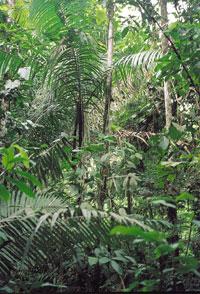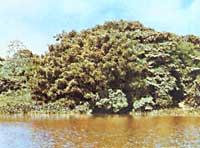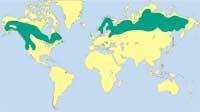The prosperity of life in the rainforest (I)
1996/01/01 Arturo Elosegi Irurtia - Ekologiako katedradunaZientzia eta Teknologia Fakultatea. EHU Iturria: Elhuyar aldizkaria
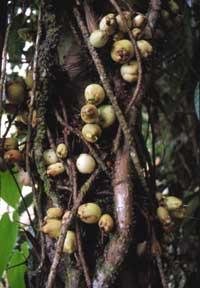
Once the first impression is overcome, discarding the first fears, if we begin to trace a little, instead of diminishing the surprise, it increases. The most curious insects, the most spectacular flowers or the most attractive birds are found in rainforests. And diversity, unlikely diversity. For example, in Costa Rica 233 vascular plant species have been found at 100 m 2! In many areas of the Amazon it is not uncommon for more than 300 tree species to appear per hectare, without repeating any. More than all tree species from all over Europe in one hectare! And leaving aside the trees, taking as criterion most other plants or animals, rainforests are the richest communities in the world.
Rainforests have appeared in hundreds of films and documentaries, usually as areas full of poisonous snakes, killer jungles that can only traverse the most adventurous. However, man has always led a quiet life. Let's see what this curious biome is and how it works with half of the species around the world, what it is and what is not true of the beliefs that circulate on the street.
Distribution of tropical rain forests
As the name suggests, rainforests are located in humid areas of the tropics. In total they occupy about 8 million km 2: half in America, a quarter in the area of India and Malaysia and the rest dispersed by Africa, Madagascar, Australia and various islands. In general, and although there are important exceptions, the average monthly temperature in tropical forests is higher than 18ºC and annual rainfall is higher than 2,400 mm. However, its distribution is more important than total rainfall, since there is no time of drought or it is very short, otherwise the arid (monsoon) rainforests would predominate. The temperature change that occurs throughout the year is less than 5 ° C, being the change from day to night as high as that of one station to another. Never make ice.
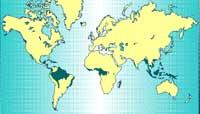
In these temperate, humid and stable conditions the plants grow easily and the seasons are little marked: most trees do not lose leaves and the flowering of different species or the fall of fruits is not synchronized. Thus, throughout the year you can find flowers, fruits and all kinds of insects. In many trees there are no rings that express the age of logs, the growth is equal throughout the year.
Biotic community
The most developed tropical rain forests have 5 layers. Logically, in each of these layers the conditions are very different, which has led to special adaptations. Larger trees, in addition to the intense sun, suffer from attacks of dry winds. They are straight trunk, hornless up to 30-40 m tall and with a wide crown, with also very wide roots and barks and often relatively small leaves and hard bark not to lose too much water.
On these giants there are epiphytes in the form of cacti: due to the little accumulation of land on the branch, the drought comes very fast for those who inhabit it. Going down the jungle the conditions stabilize: always humid, with a similar temperature, but with an increasingly smaller and greener light (worse). These bushes have large leaves, with thin cuticle and dark green. Herbaceous understory plants, in addition to chlorophyll, contain numerous auxiliary pigments to absorb poor quality light.
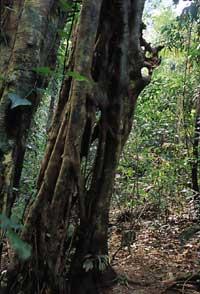
Plant life in the rain forest is a constant struggle, in competition with light, place and food. The search for light requires rapid growth and long logs, but its production requires food and in many cases the soil is poor. In our forests, most food is found in the soil, but rainforests are often concentrated in living things.
In some books it is said that in the soil there is only 1% of food from rainforests, but the statement seems exaggerated according to the data obtained. In any case, many of the rainforests trees have achieved the best food recovery system: they have fungi in symbiosis with the roots, forming mycorrhizal vesicles. These fungi absorb with extreme efficiency the food that comes from the litter, estimating that 99% of the food is absorbed before reaching 10 cm of depth. This excellent ability to recycle food is therefore the reason for its fertility. In turn, food shortages are the cause of certain climbing plants, since growing on others is cheaper than forming thick trunks.
Food shortages are the main problem of most jungle inhabitants. Monkeys, for example, often suffer from a severe lack of nitrogen due to the low protein content of tropical fruits. Nectar is also almost pure sugar and many butterflies absorb urine from large mammals (tapirra, ocapia...) to get salt. The behavior is because butterflies are clustered in the soil.
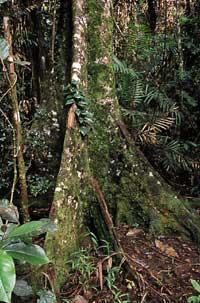
It seems that the competition for light has pushed the entire jungle to climb: going under the jungle hardly anything is seen, since most living beings are above 30 meters in the cup. In the branches of the trees grow numerous epiphytic plants and the animals that feed on their leaves and fruits are countless. Among them, as could not be otherwise, are insects, especially coleoptera (beetles) and butterflies, but also termites and ants. Among vertebrates are birds and amphibians. Although in the images of the jungle always appear snakes and monkeys, reptiles and mammals are not so abundant. Among all these groups are species that live in the trees and never descend from it.
Thus, until the development of the sampling techniques of fauna of the cups has been known only a small part of the fauna of the rain forest. And those who walk have to settle for mosquitoes, ticks and aliños, which do appear in abundance. A stroke of tiger, deer or antelope can make you happy.
Diversity of rain forests
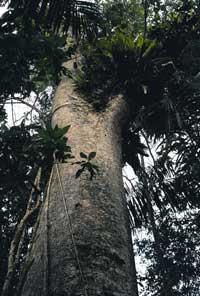
As mentioned above, tropical rain forests inhabit half or more of the species worldwide. The exact amount is not known, the more these ecosystems are investigated, the more species appear. For the inhabitants of temperate latitudes, the assimilation of the diversity of rainforests is very expensive. For example, most of our forests have one or two main tree species and we call them depending on them: oak, alisedas, spruce beech. When four or five main species appear we talk about “mixed forest”. However, it is difficult to find more than 15-20 species of trees.
In tropical rain forests it is not surprising the presence of more than 1,000 species. Of course, for the inclusion of so many species on the same surface, most must be very scarce. Thus, it is impossible to find dominants and the distance between two trees of the same species can be hundreds of meters. Despite not taking into account trees, more plant species appear in tropical rains than anywhere else. And many of these plants have invented incredible protection systems: thousands of alkaloids, phenolic substances, pheromones and toxins appear to combat herbivores.
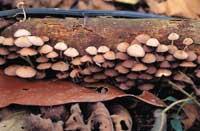
The diversity of the forest masses is not limited to vegetation, as they give stricter relationships between species than anywhere else, and specialization of animals and plants is very high. There are many species of ants that can inhabit different parts of the same tree (50 species of ants have been found in a square meter). In a Central American jungle, more than 400 species of birds have been observed over a mile. The specialization is so great that many functional groups of rainforests seem extremely rare to us: bat farms, nectarivores, bat frog hunters, arboreal snakes, snake buffs, fruit fishes...
Why feed that diversity?
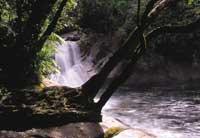
One of the biggest challenges for ecologists has been the explanation of changes in diversity; numerous theories have been built to explain these differences, many debates have been generated and although in the end you can think that everyone was right, there is no complete reason. As often happens in nature research, this enormous diversity is a consequence of many causes.
On the one hand, the tropical climate is very appropriate for most species and groups: with stable temperature and humidity, thermoregulation and drought cause much less problems than in other regions. The higher we go in latitude, the less reptiles and amphibians we will find, for example. On the other hand, year after year time is not as changing as in cold places and the incidence of natural disasters is lower, which allows populations to be given in small quantities and facilitates specialization.
In addition, the production is very high and can be distributed among many animals. They can take advantage of flowers and fruits throughout the year, which facilitates the life of many animals. In the forests of Malaysia, for example, the main trees belong to the family of dipterocarpazos, whose species bloom at different seasons of the year, so that their flowers are found throughout the year. In other words, insects have to eat all year round and there is no competition with pollinators among trees.
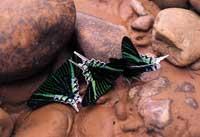
However, historical reasons also seem to have great importance in the diversity of communities. Many of today's rainforests were formed in the ancient continent of Gondwana, and as this continent broke down, each part has had a different development; while the drift of some plates has led them to different climatic regions, the rest has maintained a similar climate. In the funniest places in the jungles (some regions of the Amazon, some areas of Central America, some islands of Malaysia) the climate has changed little for millions of years, which has facilitated specialization and coevolution of species.
African or Australian forests have known drier times and are still recovering, with a lesser degree of diversity. But it should not be exaggerated when talking about climate stability in the Amazon or New Guinea. As the glaciations of the Pleistocene advanced and receded in high latitudes, in the tropical regions the stormy and interpluvial epochs were known. In interpluvial areas the forest was falling back and only a few small scars remained in the areas with a suitable microclimate. These protection zones can now be differentiated by the greater existing diversity.
Types of rain forests
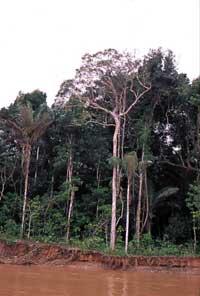
Extended in such wide areas, it is not surprising that different types of rain forests differ. The classification of forests can be done according to their appearance and environmental conditions, without taking into account the floristic composition. In short, the composition varies according to the continent; in similar means similar forests develop but with different species. What is not expert in botany will hardly separate, for example, the jungles of Ecuador, Cameroon or New Guinea, despite having very different species. The main types of rainforests are those detailed below.
Perennial tropical rainforest of the Llanada
It is the richest forest in the world and can have five plant layers: the largest trees, the giants of 40-70 m, appear quite dispersed; below them there is a continuous and narrower layer, at a height of 25-35 m; below this shed, the isolated trees that can grow in the shade, which will never be very large; below, the bushes and bushes; and the lower layer, formed by the herbs. Many of the large trees have wide kicks and roots to maintain the strength of the wind, with clear, soft bark, medium leaves and often pinnate.
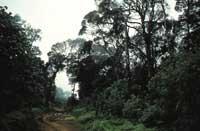
Many have a sharp end to lose water quickly and prevent parasites from marking. Epiphytic plants abound, living from the soil that has been deposited in the branches of the trees. Although the prosperity of these forests seems contrary, in most cases the soil is very poor. In these warm and humid conditions most ions dissolve and only a red, adhesive and poor clay remains: the latosol. Sometimes the sun dries that clay into a brick-like layer known as laterite.
Semi-perennial rain forest
It grows in drier conditions and looks more like the monsoon forest. Most giant trees coming out of Dosela may lose their leaves in the driest season, where conditions are quite harsh. Its diversity is less than that of the previous jungle and its structure is simpler, with a maximum of four layers. The bark of the trees is darker and rough and the woody sickles are very abundant. Because time is more variable, the seasons are more marked than in the perennial rain forest, but it is never undone.
Tropical scrub forest
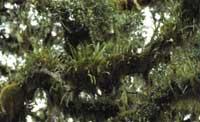
This low forest grows in sandy and very poor soils. A strong rainfall cleans the sand allows the soil to resemble high latitude podsoles: few foods and very low pH. The trees are mediocre, of small and hard leaves, as in arid regions, since the soil dries quickly. Due to food shortages, carnivorous plants are found in forests (insect bodies are sources of nitrogen and phosphorus). This type of forest is known as camping in Brazil and is abundant around Rio Negro.
Tropical mountain jungle
The rain forest, composed of medium small leaf trees and closed canopy, grows at high altitudes between 1200 and 4,000 meters. Some remain in the fog throughout the year, so they are called cloud forests, in which the trees are covered with moss and ferns, but the sarfleas are not abundant. Although we are in the tropical region, the temperature can be low, about 5-10 °C, but stable throughout the year. The slow growth of trees, which can often be seen in centenary trees, would surprise to know that they have not grown more than 15 m.
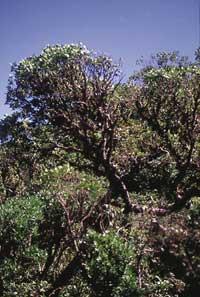
Some of the mountain rías grow in the wettest places in the world. For example, in Queensland (Australia) there are places that collect more than 10,000 liters. In these wet and cool conditions the soil tends to podsolize. These forests are not as varied as those of the plain, but the state of isolation of the mountain ranges allows to find numerous endemism.
Tropical Forest Lingerie
In this group, the floodplain forests are collected. The sand, mud and organic matter contributed by the river make the soil rich, although sometimes it has little air. To overcome this obstacle, the roots of many trees breathe from the atmosphere expelling. If floods do not penalize too much, they can be developed forests. However, the diversity is not as high as that of the perennial rain forest of the plain, since the soil is too humid for many species. In some regions the irrigation of the forest is carried out periodically, while in others it is irrigated practically all year round. In Brazil it is called the first and the second.

Gai honi buruzko eduki gehiago
Elhuyarrek garatutako teknologia



